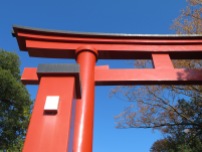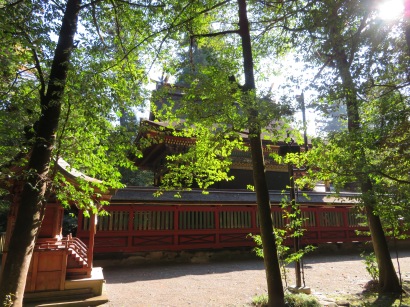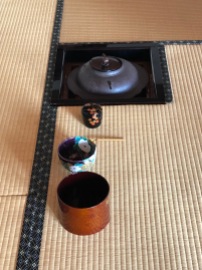These days, Gunma’s Tomioka is best known as the site of the World Heritage-listed silk reeling factory, Japan’s first modern production facility. But it has more ancient roots and more modern history as well. Some of this can be found on a hilltop about a 10 minute walk from Joshu-Ichinomiya Station.
Nukisaki Shrine: Nearly fifteen centuries of history
Ichinomiya Nukisaki Shrine is said to have been founded in the first year of the reign of Emperor Ankan (531 AD), dedicated to the gods who founded the nation as well as the gods of swords and martial arts. Later, in keeping with the economic development of this region, the gods of silk farming, weaving and production also came to be worshipped here. These days, Hime-okami, the goddess of silk farming and weaving, is the principal deity of the shrine, which is a particular favorite of silk farmers.
Nukisaki Shrine is one of only three major shrines in Japan that is approached by descending stairs rather than ascending them (the other two shrines are in Kyushu). Well, actually, most visitors first climb the hill from the opposite side, and then descend to the shrine.
According to the head priest at the shrine, most shrines were originally nestled in sheltered hollows and were approached from above, but as feng shui principles became popularized the orientation of shrines shifted so that most now have mountains behind them and water in front of them and are approached from below.
The main shrine building of Nukisaki Shrine was built in 1635 under the patronage of third shogun Tokugawa Iemitsu (1604-1651). The head priest explained that Iemitsu, who also built Nikko’s Toshogu Shrine as a mausoleum for his grandfather, Tokugawa Ieyasu (1543-1616), employed many of the same craftspeople to build Nukisaki Shrine. This is particularly evident in the carvings and other decorations of the shrine. The shrine buildings have been designated as Important Cultural Assets.
The shrine ground is heavily wooded with stately cedars, but is also known for its cherry blossoms, as is the hilltop above the shrine.
Tomioka City Social Education Hall: Pre-war Architecture at its Best
In 1934 Emperor Hirohito (posthumously known as the Showa Emperor) visited this part of Gunma for the purpose of observing troop maneuvers (Japan was already at war with China at this time). During his visit, he also stopped to pray at Nukisaki Shrine and rested nearby in the shrine’s western precincts. To commemorate this imperial visit, local officials decided to build a public hall on the site. They commissioned the architectural studio of Shintaro Oe (1879-1935), one of the leading architects of the period, to design the facility.
The result is an elegant building that is admired as a prime example of early Showa architecture and is still in use today. It, too, is an Important Cultural Asset.
The building was designed as a training facility and its original use was “mental training” for religious observation. Within a couple of years, the times being what they were, the site became a sort of spy school. After the war it became a public facility available for anyone to use for seminars, conferences, short courses, etc. Rooms that were once used as dormitory space have become classrooms and there is even a cafeteria.
Like many buildings of the period, the building is in several wings, connected by long corridors, including one that was a kind of bridge over a hollow in the landscape.
The easternmost wing (across the bridging corridor) is a kind of auditorium facility that has even been used in the past as a kind of local movie house. A small shrine is concealed behind sliding panels.
The understated decorative details through the building are refined and sophisticated.
The main room of the central part of the building is tatami, providing maximum flexibility.
It is even set up for tea ceremony, if that’s been arranged in advance.
Anyone can rent their choice of rooms for events or seminars. General visitors are also welcome to just wander through during daylight hours (except on Mondays, National Holidays and at year-end). Don’t visit Nukisaki Shrine without stopping by!
© 2022 Jigsaw-japan.com and Vicki L. Beyer
We’re thrilled if you share this; if you want to re-use in any other way, please request permission.




























